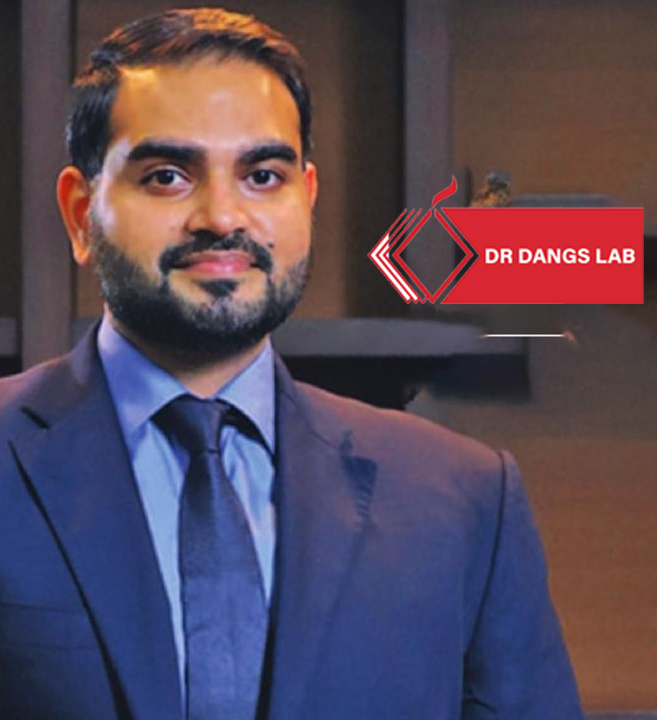Technology is like a double edged sword— a source of both promise & peril and hope & fear
Dr. Ravi GAUR. Founder & Director DRG Path Lab,New Delhi Chairman Medical Advisory Committee Unipath Specialty Laboratory, Ahmadabad In the ever-evolving landscape of healthcare, diagnostics plays a pivotal role in guiding clinical decisionmaking, personalized treatment

Dr. Ravi GAUR. Founder & Director DRG Path Lab,New Delhi
Chairman Medical Advisory Committee Unipath Specialty Laboratory, Ahmadabad
In the ever-evolving landscape of healthcare, diagnostics plays a pivotal role in guiding clinical decisionmaking, personalized treatment plans, and overall patient care. Emerging trends are revolutionizing the way diagnoses are made, treatments are developed, and the overall patient experience is enhanced.
Today we are in an exciting world of diagnostics, and which is set to reshape the future of pathology.Guided by data-driven insights and fueled by patient empowerment, the diagnostic industry, is on a transformative journey where innovation, resilience, and empathy weave together to create a mosaic of possibilities for better health and well-being. It’s a journey where personalized treatments, predictive diagnostics, and patient-centered care are not just aspirations but tangible realities.
In this dynamic environment, technology seamlessly integrates with humanity, to ensure equitable access to quality healthcare for all. The horizon shines with the promise of precision medicine, AI-driven diagnostics, and remote care, pushing the boundaries of what’s achievable. Genomics, telemedicine, and holistic wellness paint a hopeful picture on the canvas of tomorrow, illuminating a path toward a brighter, healthier future. From artificial intelligence to point-of-care testing and the expanding applications of genomic medicine are shaping a future where diagnostics is not only more accurate but also more accessible and patient-centric. Many such key developments are revolutionizing the way diseases are detected and managed.
Empowered Pathology – Artificial Intelligence (AI) – is poised to transform pathology by revolutionizing diagnostic processes, enhancing accuracy, and offering invaluable insights into patient data. As per an industry report, the global artificial Intelligence (AI) in medical diagnostics market size was exhibited at USD 1.90 billion in 2022 and is projected to hit around USD 51.56 billion by 2032, growing at a CAGR of 39.11% during the forecast period 2023 to 2032.
Through machine learning, bioinformatics, and deep learning algorithms, AI can swiftly analyze vast datasets, including images and pathology slides, identifying patterns and anomalies that may evade human detection. This AI-assisted diagnostics is being used to analyze and not only detect subtle patterns but also predict disease outcomes and personalize treatment plans based on individual patient profiles. By processing immense amounts of data rapidly, AI simplifies the diagnostic process, crucial in time-sensitive scenarios where prompt action is paramount. As AI integrates into diagnostics, it promises to elevate accuracy, streamline workflows, minimize errors, and ultimately improve patient outcomes in healthcare is also being used to accelerate drug discovery by identifying potential drug candidates and predicting their efficacy and safety. This could lead to the development of new and more effective treatments for a wide range of diseases.
But one thing is very sure, AI will augment, not replace people. There is no new paradigm where you can implement AI and suddenly the AI takes responsibility for all the decisions it’s making. We still need a human there.
Pathscope: The transition from microscopes to digital Slides – is revolutionizing pathology by overcoming geographical barriers and facilitating real-time consultations among pathologists worldwide. As per the Fortune Business Insight report, the global digital pathology market size was valued at USD 1.02 billion in 2023 and is projected to grow from USD 1.15 billion in 2024 to USD 3.86 billion by 2032, exhibiting a CAGR of 16.4% during the forecast period (2024-2032).Digital pathology’s innovative approach allows diagnostic accuracy, and seamless collaboration, particularly beneficial for under served areas and complex cases. By sharing high-resolution images and patient data, pathologists can collectively contribute to timely diagnoses, regardless of their physical location. Digital pathology represents a significant advancement, transitioning from traditional microscopy to digital slides that can be viewed, shared, and analyzed digitally. Thus, telepathology can streamline workflows, enhance accessibility, and enable efficient remote consultations, marking a transformative leap in diagnostic practices.
3D imaging: A paradigm shift in post-mortem examinations – The global 3D Medical Imaging market was valued at USD 12160 million in 2023 and is anticipated to reach USD 15810 million by 2030, witnessing a CAGR of 3.8% during the forecast period 2024-2030 (Fortune business insight report).
Some of the important applications are:
Virtual autopsy is now a reality, offering a non-invasive approach through advanced imaging techniques to create detailed 3D models of the human body. The virtual model enables collaboration among pathologists, thorough examinations without the need for invasive procedures, reducing risks, preserving the body’s integrity , and enhancing diagnostic accuracy. By utilizing imaging modalities such as CT and MRI scans, virtual autopsies provide detailed insights into internal structures, offering a less disturbing alternative to traditional autopsies and potentially increasing acceptance among families.
Forensic pathology is experiencing significant advancements, with technological tools such as 3D imaging and advanced DNA analysis techniques enhancing the accuracy and reliability of investigations into the causes of death in legal contexts. These innovations contribute vital information to legal proceedings, ensuring a more comprehensive understanding of the circumstances surrounding a person’s demise.
Decode : Genomics & Molecular pathology – are unveiling the blueprint of life and decoding diseases at a molecular level. The molecular diagnostics market is the fastest-growing segment in the in vitro diagnostics. Currently, immunoassays account for approximately 25% of the global market while molecular diagnostics account for about 6%. However, things are about to change as molecular diagnostics is poised to take a larger share of in vitro diagnostics in the years to come. The global Molecular Diagnostics Market is valued at USD 14.9 Billion in 2022 and is projected to reach a value of USD 35.8 Billion by 2030 at a CAGR (Compound Annual Growth Rate) of 11.6% between 2023 and 2030.
Through the examination of DNA and RNA from patient samples, we are now attempting to pinpoint genetic alterations that underlie disease development and insights into an individual’s genetic vulnerabilities. This knowledge is instrumental in developing finer diagnoses, including liquid biopsies, targeted therapies, predicting responses to treatments, identifying potential health risks, and customizing treatment plans for individual patients, ushering in an era of personalized medicine and minimizing the uncertainties of response.
Accessible Anywhere: Lab-on-a-Chip (LOC) Technology &Point-of-Care Testing (POCT) – is a transformative approach in healthcare, bringing diagnostic capabilities directly to where patients are, whether it’s a clinic, home, or remote area with limited resources.
The global POCT diagnostics market size was valued at USD 44.24 billion in 2023 and is projected to grow at a compound annual growth rate (CAGR) of 6.1% from 2024 to 2030. With POCT, waiting for results from distant laboratories becomes a thing of the past. These mini-lab devices provide quick and accurate results, empowering healthcare providers to make timely decisions, particularly crucial in emergencies. POCT is a game-changer, offering speed, convenience, and accessibility, revolutionizing how diagnostics are delivered and improving patient care.






